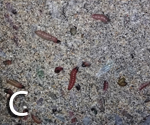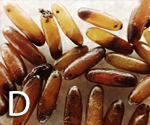Peach Moth Biocontrol
What is Peach Moth?
The Peach Moth, Grapholita molesta, (Lepidoptera: Tortricidae) is an introduced pest of orchards native to China. It was accidentally introduced in Washington, D.C. from Japan on nursery stock in 1913. By 1945 the peach moth had spread nationwide on infested fruit and nursery stock. It is now found on all continents where stone-fruit is grown.
How to Identify Peach Moth
The peach moth is a small (7-10 mm) moth, dull grayish-brown in color with a row of black dots near the end of the forewing. Larvae are thin, 10-13 mm in length, appear pinkish to creamy-white, and have a reddish-brown, apparently bisected head capsule.
Effects of Peach Moth
In the spring, adult females lay their eggs on the growing terminals of plum, cherry, quince, pear, apricot, apple, and especially nectarine and peach trees (stone-fruits). Each larva attacks at least three shoots to develop into adulthood. As much as 90% of shoots per tree can become attacked resulting in a bushy tree of lesser value. The hatching larvae mine down the new shoots causing the shoots and leaves to wither and die. This damage is often called “flagging” or “shoot strike”. Summer generations of larvae attack the ripening fruit and are especially severe on peaches. Larval feeding causes blemishing on the fruit exterior or brown rot on the interior. Early developing fruit drops off the tree if attacked. When the peach moths became established in the Grand Valley of Colorado, they caused heavy damage. So much so, they severely threatened the peach industry. The peach moth is only a problem in the Upper Grand Valley area near Palisade and Clifton including Orchard Mesa and East Orchard Mesa.
Biological Control
In the 1940s and 1950s pesticides did not work well for control of peach moth. The larvae feed inside the fruit/branch skin and thereby do not consume the sprayed material. Peach moths also have the potential to develop insecticide resistance. A more cost effective, sustainable, and safe method of control is biological. Biological control uses natural enemies such as insects, mites, or pathogens to reduce the spread, reproductive ability, or density of the target pest. The state of Colorado is fortunate to have a large program that works with biological control agents on many pest species in the state. Since 1946 the Palisade Insectary has raised a parasitic wasp that grows inside the peach moth larvae. The adults of this small wasp, Macrocentrus ancylivorus (Hymenoptera: Braconidae) called “Mac” for short, lay their eggs in the larvae of the peach moth. After Mac eggs hatch, the wasp larvae feed on the peach moth larvae until the host is consumed. Releasing Mac in late spring or early summer can control the peach moth before they attack the ripening fruit. However, Mac does not survive winters in the Grand Valley. To keep Mac in the orchards, millions are produced indoors at the Palisade Insectary for release every new growing season.
Life Stages of Peach Moth
Female moths lay eggs after 2-5 days and each can lay up to 200 eggs during the week-long oviposition period (A). Larvae grow to 12 mm, complete 4-5 instars, and leave the fruit (B) to construct cocoons and pupate on the lower tree trunk or in the substrate below (C). Pupae can also overwinter in the substrate (D). The peach moth completes 3-7 generations per year based on the length of the growing season.




FAQ
How does it work?
Last year, peach moth traps were placed in 13 orchards to monitor the adult flights. The peach moth traps were examined weekly and the locations and counts recorded. Once peach moths are found, Mac releases begin in earnest. In an average year, the Palisade Insectary releases over 1.5 million Mac into nearby peach orchards. Early research (1948) indicated a 50% reduction in fruit damage after Mac wasp releases and the wasps were just as effective as a chemical spray at the time.
The insectary in Palisade distributes the peach moth parasitoid “Mac” each year without charge. The Mac are released in the pupal (cocoon) stage at a rate of 1,000 per acre of the peach orchard. The releases come in small paper bags with some packing material and a string to tie the bags to the trees. Over the coming days, the adult wasps will emerge from their pupal casings and search the orchard for peach moth larvae to attack. Parasitoids insert the ovipositor through the peach moth feeding tunnel entrance. It then lays eggs on the peach moth larvae which hatch and consume the host from the inside. First and second instar peach moth and those moving from shoot to shoot are the most heavily parasitized.
How long will it take?
Biological control is rarely used as an eradication method. Because they are biological controls, and thus living organisms, each insect release trial can vary in target pest impact. However, this is a process that is safe, effective, inexpensive, and sustainable. It is one option within the integrated pest management plan and is ideal in commercial orchards.
What else do the wasps attack?
As current biological control practices dictate, the wasp we release is host-specific and will only target pest moth larvae. This insect has been released for many decades and is safe. It will not affect humans, livestock, or other plant species-even if host insects become difficult to find. If an agent is not host-specific enough, it does not get approved to be released.
How do I order and apply the agent?
To get peach moth parasitoids, contact the Insectary and ask to be put on the Mac list. The agents are provided free of charge. When you call, we will ask for your approximate peach acreage so we can give you the correct number of parasitoids. If you are already on the Mac list or have received parasites in the past, you don’t need to call and get on the list again because we carry over the list from year to year. Please call us if your phone number has changed or if you no longer manage peach orchards. We will call you when the releases are ready in the spring or early summer.